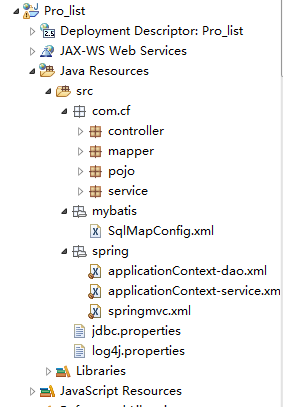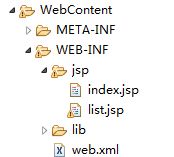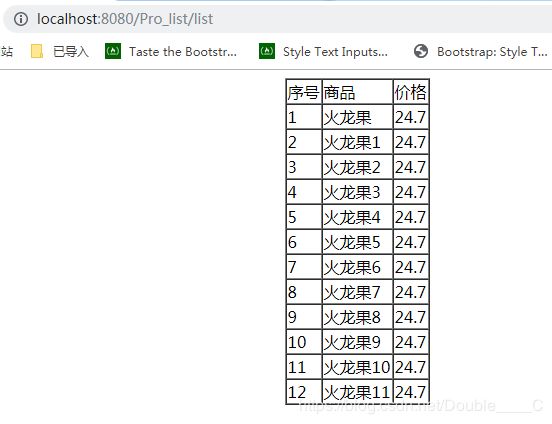SSM整合实例--(一)项目搭建
一、框架简介
SSM框架,即SpringMVC+Spring+Mybatis,其中SpringMVC与Spring可以更好的正好。对比SSH框架,Mybatis相比Hibernate更加简单易用,也更轻便,配置也较为简单。
准备做一个显示商品列表,可以进行CRUD操作的小项目,这一节先搭建环境试运行列表显示。CRUD操作后面更新。
二、项目搭建
2.2.1 mybatis配置
SqlMapConfig.xml
2.2.2 Spring配置
spring及springmvc配置都进行配置
spring配置可根据不同层次进行拆分
applicationContext-dao.xml
applicationContext-service.xml
springmvc.xml
代码中有对静态资源放行,暂时还没有静态资源,可以忽略
2.2.3 jdbc.properties
jdbc.properties
数据库配置
jdbc.driver=com.mysql.jdbc.Driver
jdbc.url=jdbc:mysql://localhost:3305/db_supermaket?characterEncoding=utf-8
jdbc.username=root
jdbc.password=root
log4j就自己添加吧
2.3 web.xml 配置
Pro_list
index.html
index.htm
index.jsp
default.html
default.htm
default.jsp
contextConfigLocation
classpath:spring/applicationContext-*.xml
org.springframework.web.context.ContextLoaderListener
encoding
org.springframework.web.filter.CharacterEncodingFilter
encoding
UTF-8
encoding
/*
product
org.springframework.web.servlet.DispatcherServlet
contextConfigLocation
classpath:spring/springmvc.xml
1
product
/
三、后台代码
3.1 mapper&pojo

mapper及pojo就不放了,是根据数据库和Mybatis逆向工程生成的。
放一下数据库的代码
CREATE DATABASE db_supermaket;
USE db_supermaket;
CREATE TABLE tb_product(
p_id INT PRIMARY KEY AUTO_INCREMENT COMMENT '商品id(主键)',
p_name VARCHAR(20) NOT NULL COMMENT '商品名称',
p_price DOUBLE NOT NULL COMMENT '商品价格'
);
INSERT INTO tb_product(p_name, p_price) VALUES ("火龙果",24.7);
INSERT INTO tb_product(p_name, p_price) VALUES ("火龙果1",24.7);
INSERT INTO tb_product(p_name, p_price) VALUES ("火龙果2",24.7);
INSERT INTO tb_product(p_name, p_price) VALUES ("火龙果3",24.7);
INSERT INTO tb_product(p_name, p_price) VALUES ("火龙果4",24.7);
INSERT INTO tb_product(p_name, p_price) VALUES ("火龙果5",24.7);
INSERT INTO tb_product(p_name, p_price) VALUES ("火龙果6",24.7);
INSERT INTO tb_product(p_name, p_price) VALUES ("火龙果7",24.7);
INSERT INTO tb_product(p_name, p_price) VALUES ("火龙果8",24.7);
INSERT INTO tb_product(p_name, p_price) VALUES ("火龙果9",24.7);
INSERT INTO tb_product(p_name, p_price) VALUES ("火龙果10",24.7);
INSERT INTO tb_product(p_name, p_price) VALUES ("火龙果11",24.7);
3.2 service层

ProductService.java
package com.cf.service;
import java.util.List;
import com.cf.pojo.TbProduct;
public interface ProductService {
//查询product的list
public List list();
}
ProductServiceImpl.java
package com.cf.service.impl;
import java.util.List;
import org.springframework.beans.factory.annotation.Autowired;
import org.springframework.stereotype.Service;
import com.cf.mapper.TbProductMapper;
import com.cf.pojo.TbProduct;
import com.cf.pojo.TbProductExample;
import com.cf.service.ProductService;
@Service
public class ProductServiceImpl implements ProductService {
//注入mapper
@Autowired
private TbProductMapper mapper;
@Override
public List list() {
//设置查询条件
TbProductExample example = new TbProductExample();
//查询
return mapper.selectByExample(example);
}
}
PageController.java
package com.cf.controller;
import java.util.List;
import org.springframework.beans.factory.annotation.Autowired;
import org.springframework.stereotype.Controller;
import org.springframework.ui.Model;
import org.springframework.web.bind.annotation.RequestMapping;
import com.cf.pojo.TbProduct;
import com.cf.service.ProductService;
@Controller
public class PageController {
@Autowired
private ProductService productService;
@RequestMapping("/")
public String index() {
return "index";
}
@RequestMapping("/list")
public String list(Model model) {
List list = productService.list();
model.addAttribute("list", list);
return "list";
}
}
3.4 JSP页面
list.jsp
页面中的pojo属性名称和数据库的字段名称有些不一样,要注意下。
因为使用逆向工程生成pojo,数据库中的下划线被去掉了。
<%@ page language="java" contentType="text/html; charset=UTF-8"
pageEncoding="UTF-8"%>
<%@ taglib uri="http://java.sun.com/jsp/jstl/core" prefix="c"%>
Insert title here
序号
商品
价格
${s.count}
${p.pName}
${p.pPrice}


